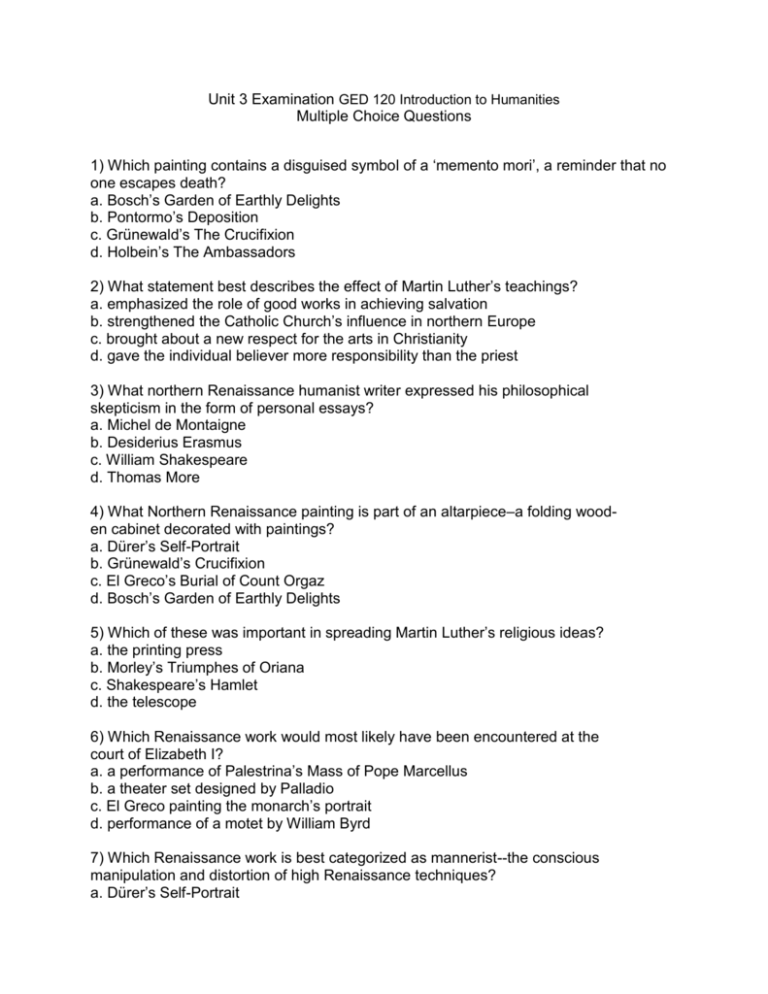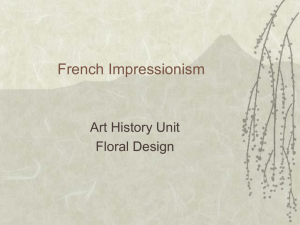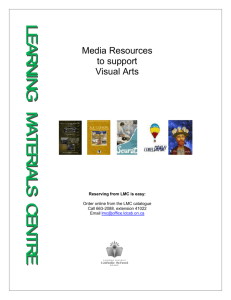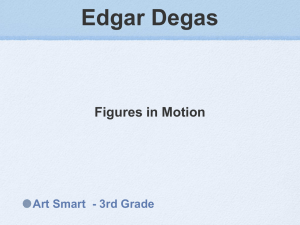unit_3_examination_ged_120_introduction_to_humanities
advertisement

Unit 3 Examination GED 120 Introduction to Humanities Multiple Choice Questions 1) Which painting contains a disguised symbol of a ‘memento mori’, a reminder that no one escapes death? a. Bosch’s Garden of Earthly Delights b. Pontormo’s Deposition c. Grünewald’s The Crucifixion d. Holbein’s The Ambassadors 2) What statement best describes the effect of Martin Luther’s teachings? a. emphasized the role of good works in achieving salvation b. strengthened the Catholic Church’s influence in northern Europe c. brought about a new respect for the arts in Christianity d. gave the individual believer more responsibility than the priest 3) What northern Renaissance humanist writer expressed his philosophical skepticism in the form of personal essays? a. Michel de Montaigne b. Desiderius Erasmus c. William Shakespeare d. Thomas More 4) What Northern Renaissance painting is part of an altarpiece–a folding wooden cabinet decorated with paintings? a. Dürer’s Self-Portrait b. Grünewald’s Crucifixion c. El Greco’s Burial of Count Orgaz d. Bosch’s Garden of Earthly Delights 5) Which of these was important in spreading Martin Luther’s religious ideas? a. the printing press b. Morley’s Triumphes of Oriana c. Shakespeare’s Hamlet d. the telescope 6) Which Renaissance work would most likely have been encountered at the court of Elizabeth I? a. a performance of Palestrina’s Mass of Pope Marcellus b. a theater set designed by Palladio c. El Greco painting the monarch’s portrait d. performance of a motet by William Byrd 7) Which Renaissance work is best categorized as mannerist--the conscious manipulation and distortion of high Renaissance techniques? a. Dürer’s Self-Portrait b. Bruegel’s The Hunters’ Return c. Parmigianino’s Madonna With the Long Neck d. Palladio’s Villa Rotonda 8) Which statement best describes the music of Palestrina? a. attempted to involve church congregations in musical worship b. directly appealed to emotions of worshippers c. pioneered the use of multiple choirs d. rejected intermingling of sacred and secular music 9) The most popular Italian export of the Renaissance was: a. opera b. commedia erudita c. commedia grave d. commedia dell’arte 10) What statement best describes the function of the Taj Mahal, in Agra, India? a. a shrine marking the site of an incident in the life of Muhammad b. a tomb of a Mughal emperor’s wife c. mosque dedicated to the Mughal faithful d. a temple where worshippers honor the Great Buddha 11) In what regard is Velazquez’s masterpiece The Maids of Honor (Las Meniñas), a scene in the artist’s royal studio, most remarkable? a. the novel treatment of a religious theme b. a brilliant use of red, blue, and gold c. its mood of gaiety and self-indulgence d. its complex arrangement of space 12) Which of these works would most likely be performed at the court of Louis XIV at Versailles? a. a cantata by J. S. Bach b. a concerto grosso by Vivaldi c. a ballet de cour by Lully d. an oratorio by Handel 13) What would the Academy, as established under the rule of Louis XIV, most likely do? a. ensure a religious content in pictures b. impose absolutist neoclassical rules on artists c. oversee the Dutch market in paintings d. encourage innovative styles of painting 14) Which of these figures is associated with the heliocentric theory of the universe, an important advance in the Scientific Revolution? a. Nicolaus Copernicus b. John Locke c. René Descartes d. Antonio Vivaldi 15) What feature or description characterizes Christopher Wren’s design for St. Paul’s Cathedral? a. use of an encircling monumental colonnade b. compromise between native English and continental elements c. the strong influence of absolutist France d. elaborate Italian baroque decoration 16) Which two artists are most closely associated with the rococo style in art? a. Jacques Louis David and Thomas Jefferson b. Peter Paul Rubens and Nicolas Poussin c. Joseph Haydn and Wolfgang Mozart d. J.-H. Fragonard and Antoine Watteau 17) In what phenomenon did the Parisian Madame Geoffrin play an important role? a. recovering the treasures of Pompeii and Herculaneum b. ending the aristocracy’s dominance in French art c. the development of ballet as an independent art form d. the success of the salon as an intellectual and social occasion 18) What term describes the idea, popularized by J.-J. Rousseau, that human society originated in an agreement among naturally free individuals to establish the rule of law and civil society? a. sensibilité b. the divine covenant c. neoclassicism d. the social contract 19) What was the most notable achievement of Marie-Elisabeth Vigée-Lebrun? a. paint flattering portraits of Europe’s nobility b. compose popular operas performed in Vienna and Prague c. reform the practice of ballet dance d. establish a famous salon in rococo Paris 20) Which of these works might have been most influenced by Palladio’s book of classical designs, an important document in eighteenth-century neoclassicism? a. Jefferson’s Monticello b. Haydn’s London symphonies c. Noverre’s ballet d’action d. Boffrand’s Hôtel de Soubise 21) Which figure, inspired by the principles of the French revolution, led the inhabitants of his Caribbean island home against the power of the Napoleonic empire? a. Toussaint l’Ouverture b. George Washington c. Símon Bolívar d. Thomas Jefferson 22) What statement best describes Goya’s Executions of the Third of May, 1808? a. creates a mysterious landscape through effects of light and color b. evokes an atmosphere of exotic pleasure and sensual delight c. expresses a romantic protest against tyranny and oppression d. shows the influence of classical sculpture in its treatment of the figure 23) Which of these romantic works inspired a set of illustrations by Delacroix, several Lieder by Schubert, and an opera by Charles Gounod? a. David, Napoleon Crossing the Alps b. Mary Shelley, Frankenstein c. Berlioz, Symphonie fantastique d. Goethe, Faust 24) For what reason would Turner’s The Slave Ship have been criticized by traditional art critics? a. disregarded precise detail in favor of atmospheric color and light b. incorporated classical sculpture and architecture c. depicted mythological creatures and fantastic scenes d. depicted a commonplace scene from ordinary life 25) Which phrase best describes program music, a frequent format of music in the romantic era? a. has a clear four-part structure b. is based on a novel or other literary work c. explicitly tells a story or describes a place d. is usually accompanied by a chorus Unit 4 Examination GED 120 Introduction to Humanities Multiple Choice Questions 1) Which term is best associated with Louis Sullivan’s Wainright Building in St. Louis and other “Chicago-style” skyscrapers? a. the steel-cage frame b. post-impressionism c. iron-and-glass construction d. exoticism 2) How is the style of Art Nouveau best described? a. expressed intense inner feelings and states of mind b. sought to depict things as they really are c. imitated models from the classical past d. employed floral and vegetal motifs 3) What stylistic term is best associated with the flowing lines and vegetal decoration of Gaudí’s Casa Milá in Barcelona? a. architectural nationalism b. post-impressionism c. Gothic revival d. Art Nouveau 4) What pair of painters sought to develop beyond the impressionist style in the direction of greater formal order and abstraction? a. Rosa Bonheur and Thomas Eakins b. Claude Monet and Auguste Renoir c. Edouard Manet and Edgar Degas d. Paul Cézanne and Georges Seurat 5) What American impressionist painter was known for paintings focused on the intimacy of mother and child? a. Claude Monet b. Auguste Renoir c. Mary Cassatt d. Edgar Degas 6) What pair of painters best defines the pure impressionist style of brilliant color and vibrant brushwork? a. Gustave Courbet and Honoré Daumier b. Paul Cézanne and Georges Seurat c. Edouard Manet and Edgar Degas d. Claude Monet and Pierre-Auguste Renoir 7) Which is a post-impressionist work that used vivid colors to achieve greater emotional power and expressiveness than the impressionists did themselves? a. Van Gogh’s Starry Night b. Seurat’s Sunday Afternoon on the Island of La Grande Jatte c. Manet’s Bar at the Folies-Bergère d. Daumier’s Rue Transnonain 8) Which of these characteristics best describes Georges Seurat’s Sunday Afternoon on the Island of La Grande Jatte? a. use of color and symbolism to impart a concentrated emotional intensity b. attempt to catch a fleeting impression of light and color c. painstaking method of applying tiny dots of color d. unbroken expanses of brilliant color in search of satisfying design 9) How is Fyodor Dostoevsky’s tale of the “Grand Inquisitor,” from his novel The Brothers Karamazov, best described? a. a feminist protest against the traditional family b. an anguished prediction of the conditions of mass society c. a savage tale of love, seduction, and murder d. an ironic examination of romantic love in the modern era 10) What Japanese art, perfected by the artists Hiroshige and Hokusai, exercised a great influence on European artists of the late nineteenth century? a. the color wood-block print b. gamelan orchestra c. the realist novel d. iron-and-glass construction 11) What figure understood the human will in light of his pessimistic conclusion that “life is given us, not to be enjoyed, but to be overcome”? a. Arthur Schopenhaur b. Charles Baudelaire c. Anton Chekhov d. Gustave Courbet 12) Which pair of works could both be classified as documentary in purpose that is, intending to record social reality directly and truthfully? a. Stravinsky, Rite of Spring, and Copland, Appalachian Spring b. Magritte, The Key of Dreams, and Miró, Birth of the World c. Dorothea Lange, Migrant Mother, and Riefenstahl, Triumph of the Will d. Joyce, Ulysses, and Eliot, The Waste Land 13) Which of these works shows most clearly modernism’s interest in “primitivism?” a. Schoenberg’s Pierrot Lunaire b. Malevich’s Black Square c. Miró’s Birth of the World d. Picasso’s Les Demoiselles d’Avignon 14) Which statement best describes Wassily Kandinsky’s Improvisation 28? a. used atonal harmonies to create an atmosphere of dissonance b. used multiple rhythms to create jarring dislocations of rhythm c. its swirling lines and color have no reference to figure or story d. painted on a geometric grid that dissolves object into planes and angular shapes 15) Which work is best classified as surrealist? a. Wright’s “Fallingwater” b. Picasso’s Three Musicians c. Charles Ives’ Three Pieces in New England d. De Chirico’s The Mystery and Melancholy of a Street 16) Which modernist figure argued that women who wanted to write needed above all an income independent of men and “a room of one’s own?” a. Dorothea Lange b. T. S. Eliot c. Leni Riefenstahl d. Virginia Woolf 17) ”I pursue the inner, hidden reality, the very essence of objects in their own intrinsic fundamental nature.” The author of this statement might have illustrated it with what work of his or her own? a. Hopper’s Nighthawks b. Duchamp’s L.H.O.O.Q c. Braque’s Le Courrier d. Brancusi’s Bird in Space 18) Which pair of figures played a central role in the invention of modern ballet? a. Louis Armstrong and Duke Ellington b. Pablo Picasso and Georges Braque c. Sergei Diaghilev and Vaslav Nijinsky d. Arnold Schoenberg and Alban Berg 19) What would one expect to encounter in listening to Igor Stravinsky’s score for Rite of Spring? a. electronic instruments b. an operatic aria c. polyrhythm and dissonance d. the sonata form 20) Which statement best describes the work of Anne Sexton and Sylvia Plath? a. was strongly influenced by the Beatles and other groups of 1960s rock-and-roll b. composed poetry in a “confessional” vein, with graphic images of female sexuality c. dealt principally with African-American characters and social life d. wrote self-consciously metaphysical stories about labyrinthine fictional worlds 21) Which statement best describes Ralph Ellison’s Invisible Man? a. dramatizes the atheistic branch of existentialist philosophy b. a largely autobiographical story of a poet’s unhappy life c. illustrates a young black man’s struggle to find his own identity d. explores an absurd world beyond logic and decency 22) Who is best categorized as an “abstract expressionist” painter of the New York school? a. Judy Chicago b. Jackson Pollock c. Andy Warhol d. Robert Smithson 23) Which work shows the sculptor’s training in automobile assembly plants and his attempt to unite art with industrial design and technology? a. Christo and Jeanne-Claude, Wrapped Reichstag b. Henry Moore, Recumbent Figure c. Louise Nevelson, Black Wall d. David Smith, Cubi XVIII 24) What American musical form rose to prominence in the age of rock-and-roll and made its African-American practitioners international pop stars? a. be-bop b. raga c. fugue d. rhythm-and-blues 25) Which is best associated with “post-modernism,” especially in its irreverent spirit and pastiche of different historical styles? a. Charles Moore’s Piazza d’Italia b. Samuel Beckett’s Waiting for Godot c. Jörn Utzon’s Sydney Opera House d. Simone de Beauvoir’s Second Sex






